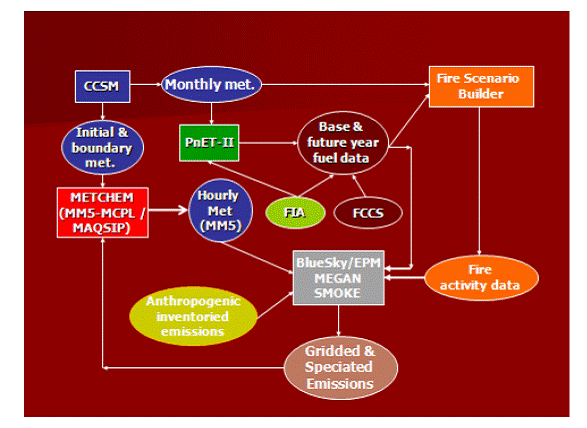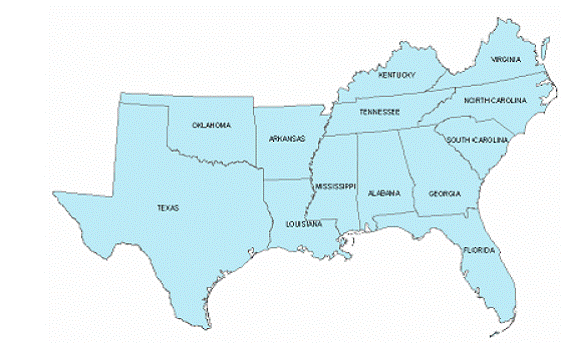Grantee Research Project Results
2007 Progress Report: Investigation of the Interactions between Climate Change, Biomass, Forest Fires, and Air Quality with an Integrated Modeling Approach
EPA Grant Number: R832277Title: Investigation of the Interactions between Climate Change, Biomass, Forest Fires, and Air Quality with an Integrated Modeling Approach
Investigators: Shankar, Uma , Hanna, Adel , Fox, Douglas G. , Binkowski, Francis S. , Xiu, Aijun , Holland, Andy , Seppanen, Catherine , Vukovich, Jeff , McNulty, Steve
Institution: University of North Carolina at Chapel Hill , USDA
EPA Project Officer: Chung, Serena
Project Period: March 13, 2005 through March 12, 2008 (Extended to March 12, 2009)
Project Period Covered by this Report: March 13, 2007 through March 12,2008
Project Amount: $726,566
RFA: Fire, Climate, and Air Quality (2004) RFA Text | Recipients Lists
Research Category: Climate Change , Air Quality and Air Toxics , Air
Objective:
Forest fires not only change landscapes and destroy property but also emit trace gases and aerosols (e.g. CO, CH4, NOx, and black carbon) that affect regional and global air quality, with consequences to human health, as well as to climate through their interactions with solar radiation. These impacts can be felt over long distances due to the long range transport of these pollutants both as primarily emitted species, and as precursors for other pollutants formed in the atmosphere through photochemical reactions. Recently, the increased frequency of large fires in the U.S. has been thought to be associated with short-term changes in climate variables such as precipitation and temperature that have exacerbated the conditions for fire occurrence. Thus the overall goal of this research is to assess the impact of climate change and variability on biomass and forest fires, the impact of the evolving emissions from forest fires on ozone and PM air quality, and the regional climate response to air quality changes in the Southern U.S using an integrated modeling system. Integration of some of these feedbacks in the model simulations will allow a more realistic representation of future-year emissions from both biogenic and fire sources, and their impact on air quality. This would facilitate assessment of the air quality and ecosystem benefits of various fire management scenarios that are currently not included in most emissions control evaluations.
The primary objectives in support of the overall goal are:
Progress Summary:
The project is a collaboration between researchers at UNC, Dr. Douglas Fox, a private consultant and fire modeling expert, and researchers at the USFS Southern Global Change Program (SGCP), led by Dr. Steven McNulty. Within the last year, Dr. Donald McKenzie from the USFS Pacific Wildland Fire Sciences Laboratory, and Dr. Jeffrey Prestemon from the USFS Southern Research Station have been active consultants on the project to provide guidance and assist in the modeling of future-year fires, and accounting for fire ignitions that are human-induced, as frequently occurs in the Southeastern U.S. (Mercer and Prestemon, 2005). The modeling system for the studies listed in the project objectives is shown in Figure 1. Research in the third year of the project focused on three key areas of development and implementation within this system: the forest growth model, PnET (Aber et al., 1996), the fire emissions model, BlueSky-EM (Sestak et al., 2002), and developing data linkages to the Fire Scenario Builder (FSB), a stochastic model for predicting fire area burned, developed by Dr. McKenzie and co-workers (McKenzie et al., 2006). The project is a collaborative effort between researchers at UNC, Dr. Douglas Fox, a private consultant and fire modeling expert, and researchers at the USFS Southern Global Change Program (SGCP), led by Dr. Steven McNulty. Within the last year, Dr. Donald McKenzie from the USFS Pacific Wildland Fire Sciences Laboratory, and Dr. Jeffrey Prestemon from the USFS Southern Research Station have been active consultants on the project to provide guidance and assist in the modeling of future-year fires, and accounting for fire ignitions that are human-induced, as frequently occurs in the Southeastern U.S. (Mercer and Prestemon, 2005). The modeling system for the studies listed in the project objectives is shown in Figure 1. In the third year of the project the team continued development and implementation tasks begun in the prior years in three key areas of this system, namely, the three-way linkages of the forest growth model, PnET (Aber et al., 1996) applied over the Southeastern U.S., the fire emissions model, BlueSky-EM (Sestak et al., 2002), and the Fire Scenario Builder (FSB), a stochastic model for predicting fire area burned, developed by Dr. McKenzie and co-workers (McKenzie et al., 2006).


Future Activities:
In the no-cost extension period of the project, the main objective will be completion of the remaining modeling tasks to examine the fire emissions impacts on air quality under various fire scenarios (wild fires only vs. National Fire Management Plan). As stated in the objectives, there has been a change to the scope of the project regarding the changes in the biogenic emissions due to fire scar, due to the difficulty of obtaining information to map the PnET vegetation types, developed at the plot level to the BELD3 1-km resolution land cover data. The project tasks will focus on the following areas:References:
Journal Articles:
No journal articles submitted with this report: View all 21 publications for this projectSupplemental Keywords:
Forest biomass, fire emissions, land cover changes, air quality climate feedbacks., RFA, Scientific Discipline, Air, Ecosystem Protection/Environmental Exposure & Risk, climate change, Air Pollution Effects, Chemistry, Monitoring/Modeling, Environmental Monitoring, Ecological Risk Assessment, Atmosphere, Community Smoke Emissions Model, anthropogenic stress, environmental measurement, meteorology, climatic influence, global ciruclation model, global change, ozone depletion, air quality model, biomass, climate models, terrestial ecosystem model, environmental stress, coastal ecosystems, ecological models, climate model, forest resources, Global Climate Change, atmospheric chemistry, climate variabilityRelevant Websites:
Progress and Final Reports:
Original AbstractThe perspectives, information and conclusions conveyed in research project abstracts, progress reports, final reports, journal abstracts and journal publications convey the viewpoints of the principal investigator and may not represent the views and policies of ORD and EPA. Conclusions drawn by the principal investigators have not been reviewed by the Agency.
